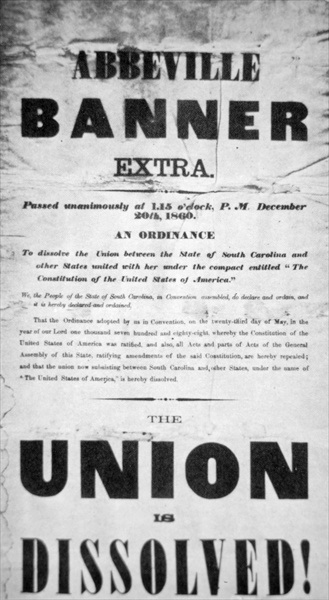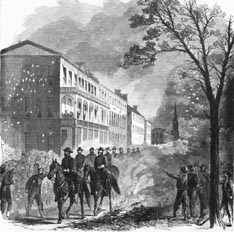
History: Civil War in South Carolina
- History
- American History Toggle Dropdown
- African American Studies and History Toggle Dropdown
- South Carolina History Toggle Dropdown
- European History
- Latin American History
- Ancient History Toggle Dropdown
- World History
- Primary Documents in History
- Primary Documents in Political Science
- Research and Writing Basics
Civil War
-
American Civil War: Topic PageThe American Civil War began in April 1861 and ended in April 1865. Those four years transformed American society.
-
Battle of Fort Wagner (18 July 1863)From Encyclopedia of the American Civil War: A Political, Social, and Military History
The storming of Fort Wagner typified the poorly planned frontal assaults launched by so many Civil War commanders. -
Battle of Honey Hill, South Carolina (30 November 1864)On 22 November 1864, Major General John G. Foster, Union commander of the Department of the South, reported to the chief of staff, Major General Henry W. Halleck, that the people of Charleston and Savannah were in a state of panic over the advance of Major General William Tecumseh Sherman’s army.
-
Battle of Port Royal Sound (4 - 5 November 1861)From Encyclopedia of the American Civil War: A Political, Social, and Military History
In the early stages of the Union blockade of Southern ports, available Federal ships were few and spread thinly along the hundreds of miles of Southern coastline. -
Battle of Successionville (16 June 1862)From Encyclopedia of the American Civil War: A Political, Social, and Military History
Federal plans to occupy Charleston, South Carolina, in June 1862 faltered after Union troops landed on James Island. -
Carolina Campaign (1 Febrary - 23 March 1865)From Encyclopedia of the American Civil War: A Political, Social, and Military History
Having completed his March to the Sea and rested briefly, Union general William T. Sherman marched out of Savannah on 1 February, 1865, his army of 60,000 accustomed to destructive war by its systematic depredations in Georgia.

-
Confederacy: Topic PageThe Confederate States of America (1861-65), the government established by the Southern states of the United States after their secession from the Union.
-
Fort Sumter: Topic PageFortification, built 1829–60, on a shoal at the entrance to the harbor of Charleston, S.C., and named for Gen. Thomas Sumter; scene of the opening engagement of the Civil War...
-
Nullification DoctrineFrom Slavery in the United States: A Social, Political, and Historical Encyclopedia
As a constitutional argument to protect southern social and economic interests, the doctrine of nullification played a significant role in the debate over slavery in the United States. -
South Carolina (Primary Documents)From Encyclopedia of the American Civil War: A Political, Social, and Military History
1. Secession Ordinance (20 December 1860)
AN ORDINANCE to dissolve the union between the State of South Carolina and other States united with her under the compact entitled “The Constitution of the United States of America.” -
SuccessionFrom Encyclopedia of the American Civil War: A Political, Social, and Military History
In an American context, secession has been understood as the withdrawal by the Southern states from the Federal Union following the election of Abraham Lincoln to the presidency in November 1860.
Images of the Civil War in South Carolin

The War in America: The Federals shelling the city of Charleston, contemporary illustration from 'The Illustrated London News' (engraving)
From Bridgeman Images: Peter Newark American PicturesCredit: The War in America: The Federals shelling the city of Charleston, contemporary illustration from 'The Illustrated London News' (engraving), English School, (19th century) (after) / Private Collection / Peter Newark American Pictures / The Bridgeman Art Library

Notice announcing that South Carolina will leave the United States, published in the Abbeville Banner Extra, 1860 (litho)
From Bridgeman Images: Peter Newark American PicturesCredit: Notice announcing that South Carolina will leave the United States, published in the Abbeville Banner Extra, 1860 (litho), American School, (19th century) / Private Collection / Peter Newark American Pictures / The Bridgeman Art Library

The Charleston Zouave Cadets of the Confederate Army, 1861 (b/w photo)
From Bridgeman Images: Peter Newark American PicturesCredit: The Charleston Zouave Cadets of the Confederate Army, 1861 (b/w photo), American Photographer, (19th century) / Private Collection / Peter Newark Military Pictures / The Bridgeman Art Library

Bombardment of Fort Sumter, Charleston Harbour
From Bridgeman Images: The Bridgeman Art LibraryCredit: Bombardment of Fort Sumter, Charleston Harbour, 12th & 13th April 1861, pub. by Currier & Ives (colour litho), American School, (19th century) / Private Collection / The Bridgeman Art Library
- Last Updated: Nov 24, 2025 5:14 PM
- URL: https://library.tctc.edu/history
- Print Page

